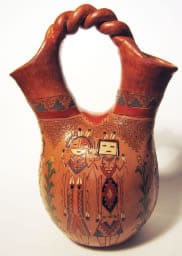
Posted on April 3, 2019
The Celts: Thriving in Spite of Globalization
The country of Ireland is one that many may recognize from phrases like “Kiss me, I’m Irish!” or perhaps through St. Patrick’s Day, a holiday where everyone wears green—just for the sake of it. Ireland as a country is also known for its stunning views, plethora of adorable sheep, and green cliffs that seem to roll straight into the sea… While the Irish people have adapted to modern lifestyle, just like most people, there are clear traces of ancient Irish culture that can still be observed today. So, even though globalization has indeed impacted Irish culture, we can analyze the ways in which the Celts have remained a large part of Irish society.
While the Irish people have adapted to modern lifestyle, just like most people, there are clear traces of ancient Irish culture that can still be observed today. So, even though globalization has indeed impacted Irish culture, we can analyze the ways in which the Celts have remained a large part of Irish society.
We will start by examining the history of Ireland. It is, after all, an island, so one must question how settlers traveled there in the first place. Historians claim that people first settled in Ireland via land bridge (or by boat) around 7000 BCE, which was called the “Stone Age”. These Stone Age people left behind weaponry and tools such as axe heads, as well as faunal remains from which we can confirm their diets consisted of mostly berries, fruit, and wild animals.
The Stone Age lasted to 2000 BCE, where the Bronze Age begun. The Bronze Age is characterized by the use of copper and tin tools in those ancient civilizations. Continuing forward in time, the Iron Age began in 500 BCE, which was characterized by the use of Iron tools (which was a much stronger material than bronze), and is considered to be the birth of real, ancient Irish culture.
The ancient Celts were a group of people who were dispersed throughout Europe, from Portugal to Turkey. When the Celts arrived in Ireland in 300 BCE, the people who were already settled there assimilated their culture. The Celts did not have a formal, central government, but were still very skilled in the art of weaponry, as well as in making chariots. The people of Rome called them “Galli” and the people of Greece called them “Keltoi”, which both meant “barbarian”. As mentioned earlier, the groups of people who were previously living in Ireland, and what is now called the United Kingdom, were displaced by the Celts, so the Gaels, Gauls, Britons, Irish, and Gallations were all known as “Celtic” people.
The culture of these ancient people is very distinct, and very magical per se. While the culture had no central focused religion (that we know of), spirituality was very important to the lifestyle of these people. For example, there were people called druids and filidhs who foretold prophecies and also judged civil and criminal cases. These druids, which means “Knowing [or Finding] the Oak Tree” in Celtic, were trained for up to twenty years, and were known for frequenting oak forests, presumably to seek knowledge of the next prophecy.
There were also many rituals that the people were involved with, such as the “Bull Sleep” ritual. In this ritual, “a chosen person was fed bull flesh and chanted to sleep by four Druids. When he awoke, he would prophecy who the next king would be.” The Celtic people also practiced animal sacrifice, as well as believed in magic and witchcraft. The Geis Bond is a magical bond which prevents a warrior from being dishonored and from dying. They also believed in a parallel, magical universe in which spiritual entities could actively come out of mounds in the ground, in the form of a fairie, (which means “Realm of the Fays”).
There are many trademark artwork and symbols that represent the Celtic culture quite well. The Triquetra, a type of triangle, represents the three stages in life: Maiden, Mother, and Wise-Woman. After Christians traveled to Ireland, the Triquetra took on the meaning of the Holy Trinity.
The Celtic Knot (which is one of many variations) symbolizes the never-ending, eternal circle of life.
The Celtic Shield Knot is a symbol that protects someone from danger and wards off evil spirits.
Lastly, the shamrock, which is debatably the most well-recognized Irish symbol today, has deeper symbolic meaning than just good luck. Legend says that St. Patrick, the “Apostle of Ireland” who spread the message of Christianity to the country, plucked a shamrock out of the ground to demonstrate the Holy Trinity (the Father, Son, and Holy Spirit). The Shamrock in Celtic tradition was already said to have mystic powers because of its capability to “stand up in the wind when a storm was approaching”. Today, most Irish people consider themselves Celtic in heritage. Over half a million people speak a Celtic language fluently, and if you travel there, you can notice that street signs and store signs are written in both English and Celtic!
Today, most Irish people consider themselves Celtic in heritage. Over half a million people speak a Celtic language fluently, and if you travel there, you can notice that street signs and store signs are written in both English and Celtic!
 With this, we can conclude that the Celtic culture is not dying out any time soon, unlike some of the other cultures we have looked at. In spite of globalization, Celtic people are expressing their culture all the more, which is a very, very good thing!
With this, we can conclude that the Celtic culture is not dying out any time soon, unlike some of the other cultures we have looked at. In spite of globalization, Celtic people are expressing their culture all the more, which is a very, very good thing!
Sources:
Britannica, The Editors of Encyclopaedia. “Druid.” Encyclopædia Britannica, Encyclopædia Britannica, Inc., 15 June 2011, www.britannica.com/topic/Druid.
“Geis | The Curse in Irish Mythology.” Aliisaacstoryteller, 19 May 2018, aliisaacstoryteller.com/2014/09/15/geis-the-curse-in-irish-mythology/.
“Iron Age People: Celts.” Ask about Ireland, www.askaboutireland.ie/learning-zone/primary-students/subjects/history/history-the-full-story/irelands-early-inhabitant/iron-age-people-celts/.

Posted on February 24, 2019
The Lost Culture & Practices of the Native Americans: The Navajo
Before any imperialistic colonization of the North and South American regions took place, there was a time where different tribes of people lived in a peaceful environment, in harmony with others and nature. To outsiders, these people seemed to be ignorant and primal. In 1493, Christopher Columbus- a man who is accredited with the discovery of America- wrote this in his letter to the Spanish rulers Ferdinand and Isabella, who also happened to be his commissioners: “They [The Indians] are all, as I said before, without any sort of iron, and they do not have any weapons, which are unknown to them, and for with they are not adapted: not because of any bodily deformity, but because they are timid and full of terror.” I would like to emphasize that Columbus claimed that the natives “were not adapted”. This seems to serve as proof of the outsider-perspective that the native American people were underdeveloped and unenlightened compared to the evidently superior, knowledgeable, and righteous white man.
Perhaps not as a direct result of Columbus’s expedition, but more as a result of the increasing desire of Western Europe to exploit the New World of its resources, the land and its native people were affected in extremely negative ways, being permanently altered. Given that an estimated 80-90% of all native American populations dropped drastically after the arrival of Columbus in the 15th and 16th centuries, (over 15 million Native Americans died), it would seem that Native American culture can never truly go back to its original state. Despite this gruesome fact, there are still some remaining tribes that have to try very hard to keep their culture and identity amidst modern attacks by the United States government and society.
The Navajo people have experienced this history firsthand. Split between the Navajo Nation and Colorado River Indian Tribe, it is the largest Native American reservation. The Navajo (or in their language, the Diné) had ancestors who were ice-age Paleo-Indian hunters in the years 12,000-6,000 BCE. These hunters dwelled in the modern-day Monument Valley region in Utah.
The region is classified as an arid desert, and would be very hard to live in for any modern-day human without technology or electricity. These hunters used special techniques in order to survive, such as foraging for edible plants. At the time, the domestication of animals did not exist, nor did subsistent agriculture. The Paleo-Indian hunters must have been in tune with their environment, and very aware of the impact and ecological footprint they were making. “Since hunter-gatherers could not rely on agricultural methods to produce food intentionally, their diets were dependent on the fluctuations of natural ecosystems.” (khanacademy.org) In a desert environment, natural wildfires, or biological successions occur in order to cleanse the environment. These are the types of natural fluctuations that Khan Academy was referencing. The purpose of these successions is to give the land the opportunity to reproduce better with the repopulation of new seedlings.
This group of people needs to be very knowledgeable regarding their own ecosystem. It can be argued that they use their knowledge not only as a means to survive, but more importantly as a means to respect the land.
In continuation with time, the culture of the native people developed. In 1,100-1,500 AD, it is reported that the first signs of Navajo culture emerged.
“Long winter nights and the seclusion of the reservation
has brought about most of the customs and activities
used by the People to entertain and amuse themselves.”
“The Navaho life is particularly rich in ceremony and ritual,
second only to some of the Pueblo groups.”
“Almost every act of their life—the building of the hogán,
the planting of crops, etc.—is ceremonial in nature,
each being attended with songs and prayers.”
Some important parts of the Navajo culture are their textiles, pottery, artworks, cultural legends, food, sand paintings, jewelry, and clothing. It is important to know that their culture has indeed changed over time, and has been greatly influenced by outsiders. For example, it wasn’t until the 17th century when the natives were taught a specific weaving pattern by the Spaniards. Also, native women were supposedly encouraged by foreigners to make their weaving more marketable, so “Navajo women began to weave rugs instead of blankets; they had already replaced the blankets they wove for their own use with machine-made blankets…”
Here are some photos of these cultural items:
The Native Americans as a whole have been victims of westward expansion, and still are today. Even though the Manifest Destiny attitude has historically ended, there are still issues like globalization, technological advancement, and the ever-growing need for more land, that are endangering the culture of these natives.
In times like these, we must ask ourselves a question of priority. Is culture really that important?
Culture, in my mind, can be viewed as an endangered species. It is something precious. Once forgotten, culture cannot be remembered. Once dead, it cannot come back to life.
Perhaps, we can find answers to life’s biggest mysteries not through more and more technological advancement, but through the ancient knowledge, beauty, and seemingly supernatural understanding that the Navajo People already have, and have always had since the very beginning.
Sources:
“Ancient Navajo and Native Americans Migrations.” Navajo Code Talker, navajopeople.org/blog/ancient-navajo-and-native-americas-migrations/.
Carey, Harold. “Navajo People – The Diné.” Navajo Code Talker, navajopeople.org/.
Leyden, Kimberly. What Was Columbus’s Attitude toward the Native People of the Islands and How Did This Affect His Treatment of Them? . ucbhssp.berkeley.edu/sites/default/files/hssplessons/Columbus and Native Peoples Lesson.pdf.
“Paleolithic Societies.” Khan Academy, Khan Academy, www.khanacademy.org/humanities/world-history/world-history-beginnings/origin-humans-early-societies/a/what-were-paleolithic-societies-like.

Posted on January 29, 2019
The Khoi-Khoi & San
Our world is changing drastically in many ways. With a rise in globalization, older cultures are being forgotten and left behind. This is because globalization calls for people to leave behind their old ways, and to join the bandwagon of globalization.
Which cultures are being forgotten, and lost? How can we save them?
National Geographic’s definition of globalization is simply, “the connection of different parts of the world”. So, globalization is connection. Our world is an ever-increasing place of technological advancement, where “knowledge” is at our fingertips and western entertainment and wireless cell phone signals and technology is being made available in even the most remote locations.
This does seem like a very good thing. Globalization is allowing people in remote locations to have “the chance to develop economically” which “creates the conditions in which democracy and respect for human rights may flourish” according to Mike Collins, who has 35 years of experience in manufacturing, in Forbes Magazine.
However, there are some drawbacks to the effects of globalization: cultural losses.
At the start of South African history, African migrants from the north travelled southward to populate those areas. This event, called the “Bantu Migration”, occurred around 1000 AD – 1800 AD. As time progressed, two groups evolved from this initial migration: the Khoi-Khoi, who were pastoralists, and the San, who were hunter-gatherers. (Even though the pastoral and hunter-gatherer lifestyles are very different from the ones we have today, that does not mean that these cultures were “less developed” or “primal”).
The opinion regarding the “primitiveness” of these African cultures heavily influenced European settlers desire to exploit Africa beginning in the late 17th century, and continuing with the “Scramble for Africa”, which occurred in the late 19th and early 20th centuries. In this event, European countries engaged in New Imperialism; they conquered, invaded, divided, and occupied the entire continent of Africa. This, which I consider to be a form of globalization and world-connectedness, impacted the Khoi-Khoi and San cultures in very negative ways.
According to Andrew Thompson, a writer and traveler in South Africa, “The disruption to grazing patterns, the exploitation of natural resources, the spread of imported diseases and various other conflicts had a direct impact on the population of the Khoi and the San. Over the subsequent years their populations went into a sharp decline.”
Not only was their culture threatened by population loss, but by government repression as well. South Africa’s apartheid system made laws that grossly separated people of different races:
It was from this apartheid system where the name “Khoisan” came about- even though the Khoi-Khoi and San peoples were diverse and numerous, government leaders blended their names together to “simplify” things, which was and is very offensive to them, given that their lifestyles were and are completely different.
It is through this culture-blending and western influence where we can observe that the Khoisan culture is actually dying- but what does it mean for a culture to die?
Cultural losses or cultural deaths is when a group of a certain culture either voluntarily or involuntarily assimilates to the more “dominant” culture, forgetting their unique knowledge, craftsmanship, language, and way of life.
In cultural losses and deaths, we are faced with several challenges and questions of importance and priority. Initially, the Khoisan people were said to have “remarkable skills and knowledge”, such as the ability to “tune in to their surroundings” and hunt large creatures with only the aid of a “poison-tipped arrow”. They also had an ability to extract nutrients from plants, and a rare knowledge of the medicinal value of these nutrients. In Thompson’s article, he further specifies that “Traditional music and singing are no longer as prevalent, and the art of making weapons, traditional jewelry and clothing are starting to be diluted by modern western cultures.”
The Khoisan people also use a conglomeration of the most complex languages in the world, which many people refer to as the “click languages”. This is because the people use different audible clicks with their dental and nasal areas:
The Khoisan culture has developed in a way that is not primal at all, but seems to be complex, intricate, intelligent, and filled to the brim with knowledge beyond that even Westerners can understand! Some may say that cultural loss is a good thing: Kwabena Taiwo, a UK based writer and lawyer, claims that in his article, titled “Indigenous African Languages are Dying Out and it’s a Good Thing”. His main argument centralizes around the idea that Africa’s wide variety of language-speakers has contributed to its inability to unite and to thrive in the developing world.
Even though this point of view may be true, the unique language and intelligence of groups like the Khoisan offer the globalized and culturally-assimilated individuals of the world- who make up the majority- a rare look into a different way the human race has developed. Just because the Khoisan culture has not developed technologically like most of the world has, this does not mean that they are “less developed” or “primal”. It simply means that they have developed in a different way than the rest of the world, and I think that calls for some praise- to ignore the entire world and continue in one’s own culture- that is a very, very special thing.
Knowledge is important. If we lose the Khoisan culture, we will lose their knowledge, their language, and the potential to see the human race from a new lens, one that proves the complexity and intelligence and variety of human mind, one that gives us a glimpse into true diversity and true culture.
Sources:















